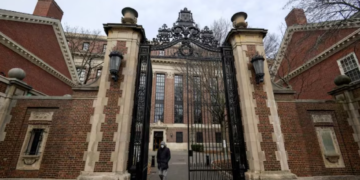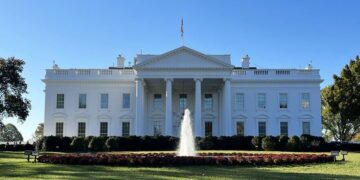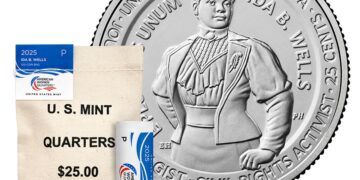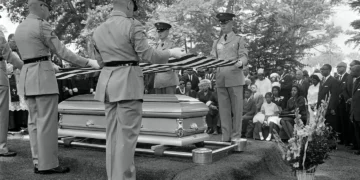Researchers and burial oversight committee member Brenda Alford transport the first set of remains exhumed from the recent dig site in Oaklawn Cemetery to an onsite lab for further examination on Wednesday, September 13, 2023, in Tulsa, Oklahoma. They are searching for victims of the 1921 Tulsa Race Massacre. (Mike Simons /Tulsa World via AP)
July 15, 2024 Story by: Editor
Over a century after a white mob destroyed the Greenwood district of Tulsa, Oklahoma, known as Black Wall Street, the city has made significant progress in identifying the victims.
Tulsa officials announced a “major scientific breakthrough” in the search for graves of those killed in the 1921 Tulsa Race Massacre. Six sets of exhumed remains have yielded DNA profiles that can be traced to living relatives.
“At every stage of the search, the city’s primary objective has been to identify missing victims and reunite their remains with their families,” Tulsa Mayor G.T. Bynum said at a news conference on Wednesday. He highlighted that analyzing genetic genealogy profiles and finding links to 19 surnames marks a critical step in this process.
In 2020, nearly a century after a white mob killed up to 300 people in Greenwood, a prosperous Black neighborhood, the city began excavating a section of Oaklawn Cemetery. Evidence suggested a possible mass gravesite in this area.
State archaeologist Kary Stackelbeck led exhumations in 2021 and 2022, with consultation from forensic anthropologist Phoebe Stubblefield. They analyzed the remains of 22 individuals for DNA.
Officials cautioned that they could not confirm if the six sets of remains, four male and two female, belonged to massacre victims. The project’s goal is to “recover as much information as possible that would allow us to discern whether these individuals represent victims or not,” Dr. Stackelbeck explained.
The investigation involved extensive soil testing around the cemetery and consultation with experts in wood and ammunition. One case involved analyzing a set of keys buried for over a century.
The Tulsa Race Massacre started with a false accusation. On May 31, 1921, a white mob gathered outside a courthouse where a young Black man was held over allegations of attacking a young white woman who operated an elevator. Although the man was cleared, a fight broke out when a group of white men clashed with Black men at a police station.
The mob descended on Greenwood, burning it to the ground with the National Guard’s assistance. The death toll was as high as 300, making it one of the worst acts of racial violence in American history. Hundreds were injured, and an estimated 8,000 were left homeless.
After the massacre, officials tried to erase it from the city’s history. Victims were buried in unmarked graves, and police records vanished. The city only began addressing the massacre’s legacy in the late 1990s, leading to a 2001 report by a commission investigating the event.
In an interview on Thursday, Mayor Bynum said the exhumation effort was “this generation of Tulsans trying to do what should’ve been done 100 years ago.”
No one has been held accountable for the deaths or destruction. However, a judge ruled last year that three survivors could proceed with part of a lawsuit seeking reparations.
Brenda Nails-Alford, a descendant of massacre victims and a member of the 1921 Graves Investigation Public Oversight Committee, said at Wednesday’s news conference that identifying the remains would “bring some sense of justice and healing to our community.”
Officials hope the six sets of remains that yielded genetic genealogy profiles will lead researchers to living descendants. They associated 19 possible surnames with the remains and saw potential connections to at least seven states: Alabama, Georgia, Louisiana, Mississippi, North Carolina, Oklahoma, and Texas.
Mayor Bynum anticipates more breakthroughs. “We have documentary evidence that Tulsa County paid for 18 — the term used on the invoice — ‘riot dead’ to be buried in this cemetery,” he said. “We’re trying to find them.”
Over the past six months, project organizers have urged anyone who may be a descendant of a victim to submit information, and about 100 people have responded. Alison Wilde, the genealogy case manager, hopes that specifying the states and surnames will encourage more participation.
The six remains fit the profile forensic scientists were looking for, even if not yet confirmed as victims. Identifying them will advance investigations and improve understanding of burial patterns at the cemetery, Ms. Wilde said.
The team of archaeologists, anthropologists, genealogists, and forensic scientists emphasized that public assistance is crucial.
“This last step is in their hands or in their blood, as it were,” Dr. Stackelbeck said. “Or in their spit.” Source: The New York Times
















